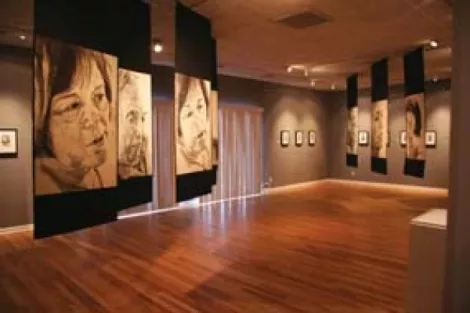
It can be very difficult with portraiture not to have the subject appear merely as a reflection of a person sitting for a picture. The image can seem iconic, with no real relationship to anything hung with or around it, or as a rigid replica of someone with social standing that doesn’t necessarily resonate with viewers. Suflita never had the main intent of making portraits; the work is more about the specificity of people, she says, as if she almost borrows their faces to do her own thing. And her portraits as a group read almost like a visual novella of relationships rather than just a series of sitters.
Aiming to explore group relationships with her work for this show, Suflita both framed the individual in her smaller prints and then strung these same portraits together to form “In the Moment”—a book she also printed and bound herself. Just like colors change depending on which other colors they are paired with or placed up against, Suflita says, so do people in varying social contexts. Her prints are as academic as color theory, with their traditional cropping and hatching and the overall angular structural approach to light, shade and form.
Her artist bio and statement even alludes to a straightforward figural background. But the portraits pose a question: Exactly what is left to the imagination? And the slight tension this provides and the complete lack of eye contact with the viewer leave patrons feeling like they have intruded upon these restless people grouped together. This small discomfort sets the portraits apart from the countless others that academia has previously regurgitated.
The presentation also sets them apart. Walking into a room packed with pictures of people who—because of their far-off gazes—appear to be avoiding something, makes the show an illustrated group therapy of sorts. Their vague unspoken expressions are not foreign forms of communications. Even in a single portrayal, the works communicate mild distresses that are familiar to most. Giant prints of couples sewn on to large strips of black fabric hang like banners diagonally across the gallery. Each pair is shown twice, and each portrait is back to back with the same gender of another couple. Their privacy is removed and their intense, intimate and taut exchanges—appearing to have occurred moments before it was captured on paper—is exposed and almost obsessively rendered.
This presentation draws comparisons to and makes evident the effect and change over time transient sentiments have on relationships. “I’m hypersensitive to the emotional temperature, the atmosphere of a situation,” Suflita says, and this translates to her work in an abstract way. With the exception of one small self-portrait, all the prints imply deeper emotional sensitivities of others. And although they are voyeuristic, they also disclose a certain acuity about the artist herself and hint at her own emotional interior.
These investigations are the core of her work and artistic exploration. “This work is the most honest I can be,” Suflita says; “it is so sincerely from me.” It is a show that requires perspicacity on the part of the viewer to look past the portrait as just a picture and see what else they can extract from it. Any one piece on its own has a far different tone from the cohesion of the show as a whole. Together, it is a sum of its parts.
JENNIFER MARIE SUFLITA: ETCHINGS & DRY POINT Finch Lane Gallery, 1325 E. 100 South, 596-5000. Through April 11